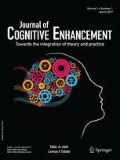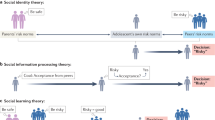Abstract
Adolescence is a period of heightened risk taking relative to both adulthood and childhood, due in part to peers’ increased influence on adolescent decision making. Because adolescents’ choices have harmful consequences, there is great interest in specific interventions that might attenuate risk taking. We hypothesized that it might be possible to reduce adolescent risk taking through an intervention targeting the ability/tendency to engage cognitive control processes. While some studies of working memory training (WMT) have indicated subsequent enhancement of adults’ cognitive control abilities, potential impacts on adolescent cognitive control have not been explored. Accordingly, we tested whether 4 weeks of WMT (relative to active control training, ACT) might increase performance on cognitive control measures and decrease risk taking in adolescents. Adolescents receiving WMT, compared to those receiving ACT, exhibited some evidence of improved short-term memory performance following the 4-week training period. Improvements did not significantly transfer to performance on basic cognitive control measures. However, on two risk-taking tasks administered at post-training either with or without an anonymous peer audience, adolescents who received WMT evinced suppressed levels of risk taking when observed by peers, an effect not seen in ACT. Further work is needed to more fully characterize the potential of WMT interventions in stemming risk behavior within adolescent samples.


Similar content being viewed by others
References
Aïte, A., Cassotti, M., Linzarini, A., Osmont, A., Houdé, O., & Borst, G. (2016). Adolescents’ inhibitory control: keep it cool or lose control. Developmental Science, (January), 1–9.
Albert, D., Chein, J. M., & Steinberg, L. (2013). The teenage brain: peer influences on adolescent decision making. Current Directions in Psychological Science, 22(2), 114–120.
Au, J., Sheehan, E., Tsai, N., Duncan, G. J., Buschkuehl, M., & Jaeggi, S. M. (2015). Improving fluid intelligence with training on working memory: a meta-analysis. Psychonomic Bulletin & Review, 22, 366–377.
Bickel, W. K., Yi, R., Landes, R. D., Hill, P. F., & Baxter, C. (2011). Remember the future: working memory training decreases delay discounting among stimulant addicts. Biological Psychiatry, 69(3), 260–265.
Borella, E., Carretti, B., Riboldi, F., & De Beni, R. (2010). Working memory training in older adults: evidence of transfer and maintenance effects. Psychology and Aging, 25(4), 767.
Botdorf, M., Rosenbaum, G. M., Patrianakos, J., Steinberg, L., & Chein, J. M. (2016). Adolescent risk-taking is predicted by individual differences in cognitive control over emotional, but not non-emotional, response conflict. Cognition and Emotion, 9931(April), 1–8.
Burnett, S., Bault, N., Coricelli, G., & Blakemore, S. J. (2010). Adolescents’ heightened risk-seeking in a probabilistic gambling task. Cognitive Development, 25(2010), 183–196.
Casey, B. J., Galvan, A., & Somerville, L. H. (2016). Beyond simple models of adolescence to an integrated circuit-based account: a commentary. Developmental Cognitive Neuroscience, 17, 128–130.
Chein, J. (2015). Peers and adolescent risk taking. Emerging trends in the social and behavioral sciences. Edited, 1–13.
Chein, J., Albert, D., O’Brien, L., Uckert, K., & Steinberg, L. (2011). Peers increase adolescent risk taking by enhancing activity in the brain’s reward circuitry. Developmental Science, 14(2), F1–10.
Chein, J., & Morrison, A. (2010). Expanding the mind’s workspace: training and transfer effects with a complex working memory span task. Psychonomic Bulletin & Review, 17(2), 193–199.
Clayton, R., Cattarello, A., & Johnstone, B. (1996). The effectiveness of drug abuse resistance education project. Preventative Medicine, 31825, 307–318.
de Water, E., Cillessen, A. H. N., & Scheres, A. (2014). Distinct age-related differences in temporal discounting and risk taking in adolescents and young adults. Child Development, 85(5), 1881–1897 https://doi.org/10.1111/cdev.12245.
Defoe, I. N., Dubas, J. S., Figner, B., & Van Aken, M. A. G. (2015). A meta-analysis on age differences in risky decision making: adolescents versus children and adults. Psychological Bulletin, 141(1), 29.
Ennett, S. T., Tobler, N. S., Ringwalt, C. L., & Flewelling, R. L. (1994). How effective is drug abuse resistance education? A meta-analysis of project DARE outcome evaluations. American Journal of Public Health, 84(9), 1394–1401.
Figner, B., Mackinlay, R. J., Wilkening, F., & Weber, E. U. (2009). Affective and deliberative processes in risky choice: age differences in risk taking in the Columbia Card Task. Journal of Experimental Psychology. Learning, Memory, and Cognition, 35(3), 709–730.
Gardner, M., & Steinberg, L. (2005). Peer influence on risk taking, risk preference, and risky decision making in adolescence and adulthood: an experimental study. Developmental Psychology, 41(4), 625–635.
Hautus, M. J. (1995). Corrections for extreme proportions and their biasing effects on estimated values of d′. Behavior Research Methods Instruments, & Computers, 27(1), 46–51.
Jaeggi, S. M., Buschkuehl, M., Shah, P., & Jonides, J. (2014). The role of individual differences in cognitive training and transfer. Memory & Cognition, 42(3), 464–480.
Kann, L., Kinchen, S., Shanklin, S. L., Flint, K. H., Kawkins, J., Harris, W. A., … Zaza, S. (2012). Youth risk behavior surveillance—United States, 2011, Morbidity and mortality weekly report. Surveillance summaries (Washington, D.C.: 2002) 61(4), 1–168.
Karbach, J., & Verhaeghen, P. (2014). Making working memory work: a meta-analysis of executive-control and working memory training in older adults. Psychological Science, 25(11), 2027–2037.
Kun, Y. (2007). Impact of computerized cognitive training on working memory, fluid intelligence, science achievement (doctoral dissertation).
Melby-Lervåg, M., & Hulme, C. (2013). Is working memory training effective? A meta-analytic review. Developmental Psychology, 49(2), 270–291.
Melby-Lervåg, M., Redick, T., & Hulme, C. (2016). Working memory training does not improve performance on measures of intelligence or other measures of “far transfer”: evidence from a meta-analytic review. Perspectives on Psychological Science, 11(4), 512–534.
Mitchell, S. H., Schoel, C., & Stevens, A. A. (2008). Mechanisms underlying heightened risk taking in adolescents as compared with adults. Psychonomic Bulletin & Review, 15(2), 272–277.
Morrison, A. B., & Chein, J. M. (2011). Does working memory training work? The promise and challenges of enhancing cognition by training working memory. Psychonomic Bulletin & Review, 18(1), 46–60.
O’Brien, L., Albert, D., Chein, J., & Steinberg, L. (2011). Adolescents prefer more immediate rewards when in the presence of their peers. Journal of Research on Adolescence, 21(4), 747–753.
Paulsen, D. J., Carter, R. M., Platt, M. L., Huettel, S. A., & Brannon, E. M. (2012). Neurocognitive development of risk aversion from early childhood to adulthood. Frontiers in Human Neuroscience, 5(January), 1–17.
Preston, S. D., & Stansfield, R. B. (2008). I know how you feel: task-irrelevant facial expressions are spontaneously processed at a semantic level. Cognitive, Affective & Behavioral Neuroscience, 8(1), 54–64.
Pugin, F., Metz, A. J., Stauffer, M., Wolf, M., Jenni, O. G., & Huber, R. (2014). Working memory training shows immediate and long-term effects on cognitive performance in children and adolescents. F1000Research, (0), 1–10.
Richmond, L. L., Morrison, A. B., Chein, J. M., & Olson, I. R. (2011). Working memory training and transfer in older adults. Psychology and Aging, 26(4), 813–822.
Romer, D., Betancourt, L. M., Brodsky, N. L., & Giannetta, J. M. (2012). Does adolescent risk taking imply weak executive function? A prospective study of relations between working memory performance, impulsivity, and risk taking in early adolescence. Developmental Science, 14(5), 1119–1133.
Sala, G., & Gobet, F. (2017). Working memory training in typically developing children: a meta-analysis of the available evidence. Developmental Psychology.
Salminen, T., Strobach, T., & Schubert, T. (2012). On the impacts of working memory training on executive functioning. Frontiers in Human Neuroscience, 6, 1–14.
Shavelson, R., Yuan, K., & Alonzo, A. (2008). On the impact of computerized cognitive training on working memory and fluid intelligence. In D. C. Berliner & H. Kuppermintz (Eds.), Contributions of educational psychology to changing institutions, environments, and people (pp. 1–11). New York, NY: Routledge.
Shipstead, Z., Redick, T. S., & Engle, R. W. (2012). Is working memory training effective? Psychological Bulletin, 138(4), 628–654.
Shulman, E. P., Smith, A. R., Silva, K., Icenogle, G., Duell, N., Chein, J., & Steinberg, L. (2016). The dual systems model: review, reappraisal, and reaffirmation. Developmental Cognitive Neuroscience, 17(2015), 103–117.
Simons-Morton, B., Lerner, N., & Singer, J. (2005). The observed effects of teenage passengers on the risky driving behavior of teenage drivers. Accident Analysis and Prevention, 37(6), 973–982.
Simons-Morton, B., Ouimet, M. C., Zhang, Z., Klauer, S., Lee, S. E., Wang, J., et al. (2011). The effect of passengers and risk-taking friends on risky driving and crashes/near crashes among novice teenagers. Journal of Adolescent Health, 49(6), 587–593.
Smith, A. R., Chein, J., & Steinberg, L. (2014). Peers increase adolescent risk taking even when the probabilities of negative outcomes are known. Developmental Psychology, 50, 1564–1568.
Somerville, L. H., Hare, T., & Casey, B. (2012). Frontostriatal maturation predicts cognitive control failure to appetitive cues in adolescents. Journal of Cognitive Neuroscience, 23(9), 2123–2134.
Steinberg, L. (2008). A social neuroscience perspective on adolescent risk-taking. Developmental Review, 28(1), 78–106.
Steinberg, L., Albert, D., Cauffman, E., Banich, M., Graham, S., & Woolard, J. (2008). Age differences in sensation seeking and impulsivity as indexed by behavior and self-report: evidence for a dual systems model. Developmental Psychology, 44(6), 1764–1778.
Steinberg, L., & Monahan, K. C. (2007). Age differences in resistance to peer influence. Developmental Psychology, 43(6), 1531–1543.
Unsworth, N., Heitz, R. P., Schrock, J. C., & Engle, R. W. (2005). An automated version of the operation span task. Behavior Research Methods, 37(3), 498–505.
Weicker, J., Villringer, A., & Thöne-Otto, A. (2015). Can impaired working memory functioning be improved by training? A meta-analysis with a special focus on brain injured patients. Neuropsychology, 30(2), 1–23.
Weigard, A., Chein, J., Albert, D., Smith, A., & Steinberg, L. (2014). Effects of anonymous peer observation on adolescents’ preference for immediate rewards. Developmental Science, 17(1), 71–78.
West, S. L., & O’Neal, K. K. (2004). Project D.A.R.E. outcome effectiveness revisited. American Journal of Public Health, 94(6), 1027–1029.
Wysong, E., & Wright, D. W. (1995). A decade of DARE: efficacy, politics and drug education. Sociological Focus, 28(3), 283–311.
Zimring, F. E. (2000). American youth violence. Oxford University Press.
Acknowledgements
We would also like to thank Drs. Susanne Jaeggi and Martin Buschkuehl for the use of their n-back task.
Funding
This work was supported by an R21 from the National Institute on Drug Abuse (DA031436) awarded to JMC and LS.
Author information
Authors and Affiliations
Corresponding author
Rights and permissions
About this article
Cite this article
Rosenbaum, G.M., Botdorf, M.A., Patrianakos, J.L. et al. Working Memory Training in Adolescents Decreases Laboratory Risk Taking in the Presence of Peers. J Cogn Enhanc 1, 513–525 (2017). https://doi.org/10.1007/s41465-017-0045-0
Received:
Accepted:
Published:
Issue Date:
DOI: https://doi.org/10.1007/s41465-017-0045-0




